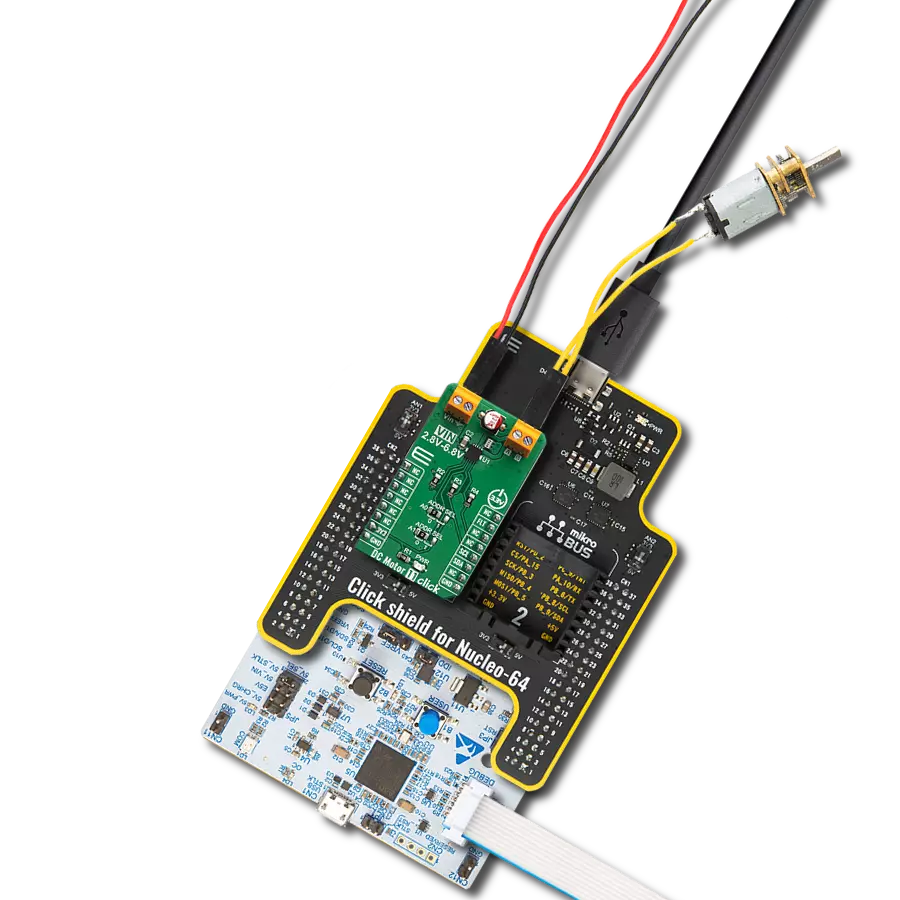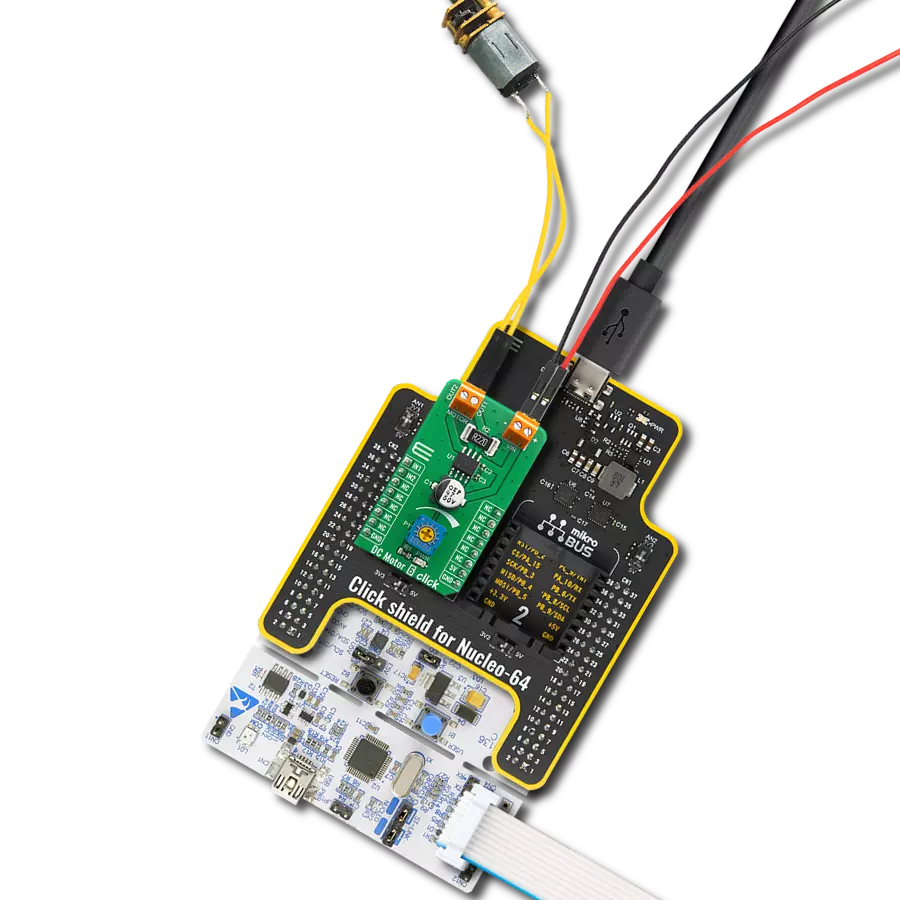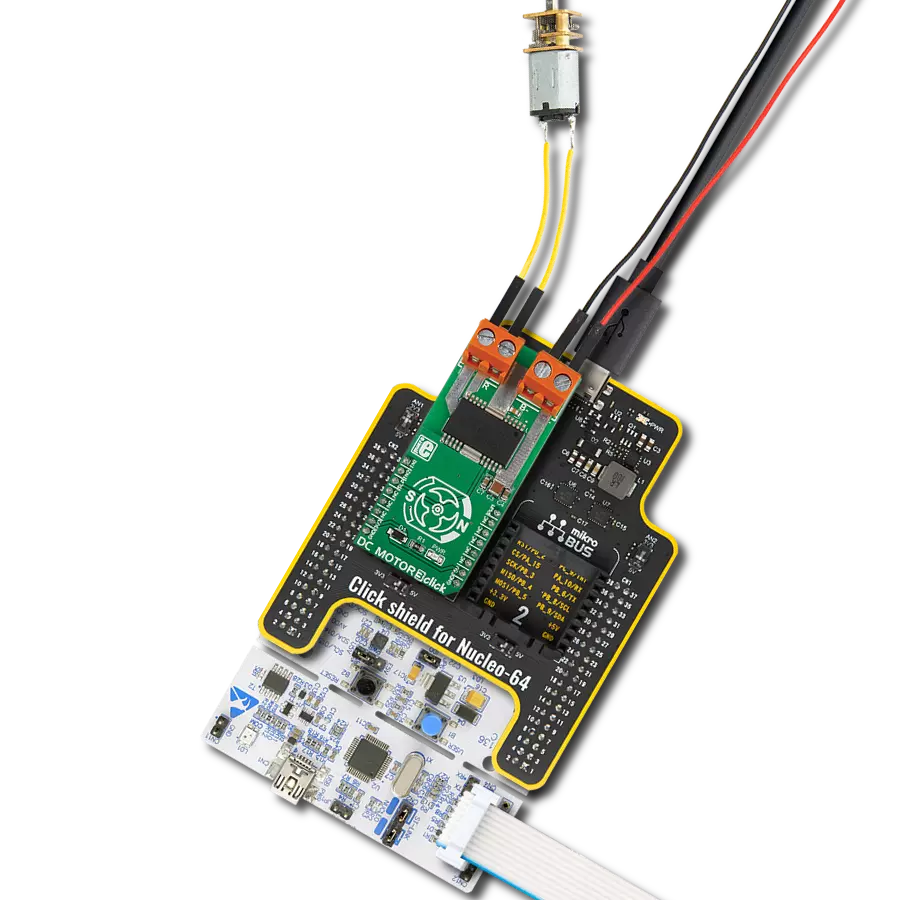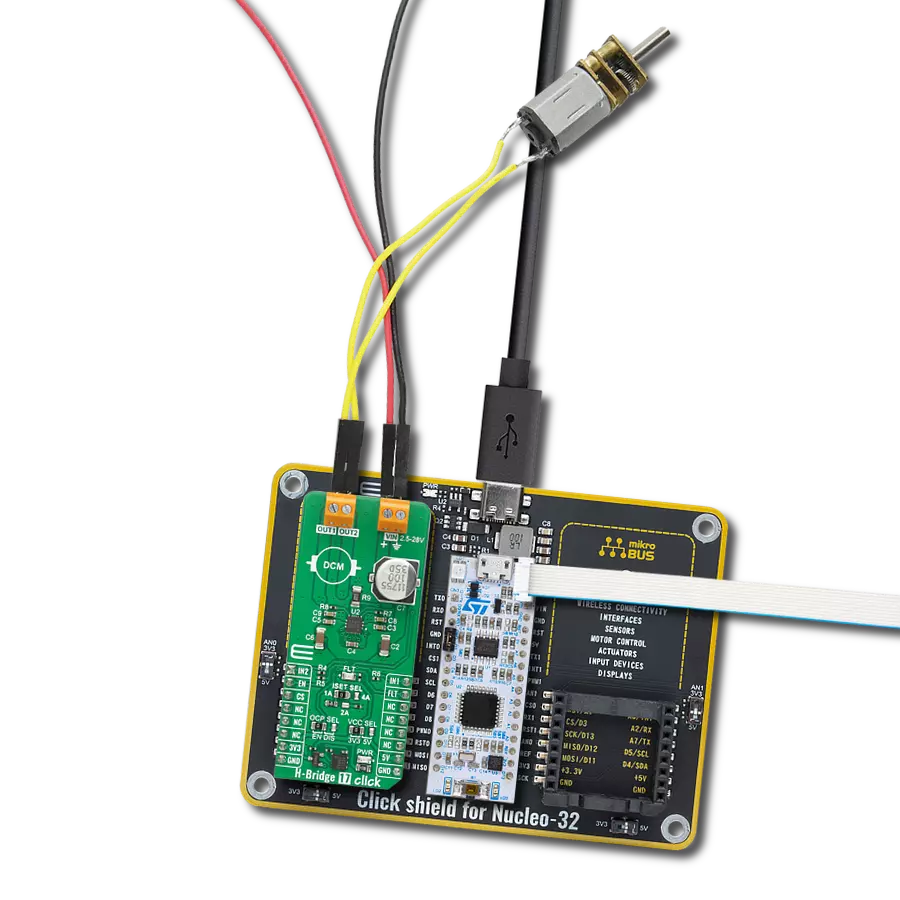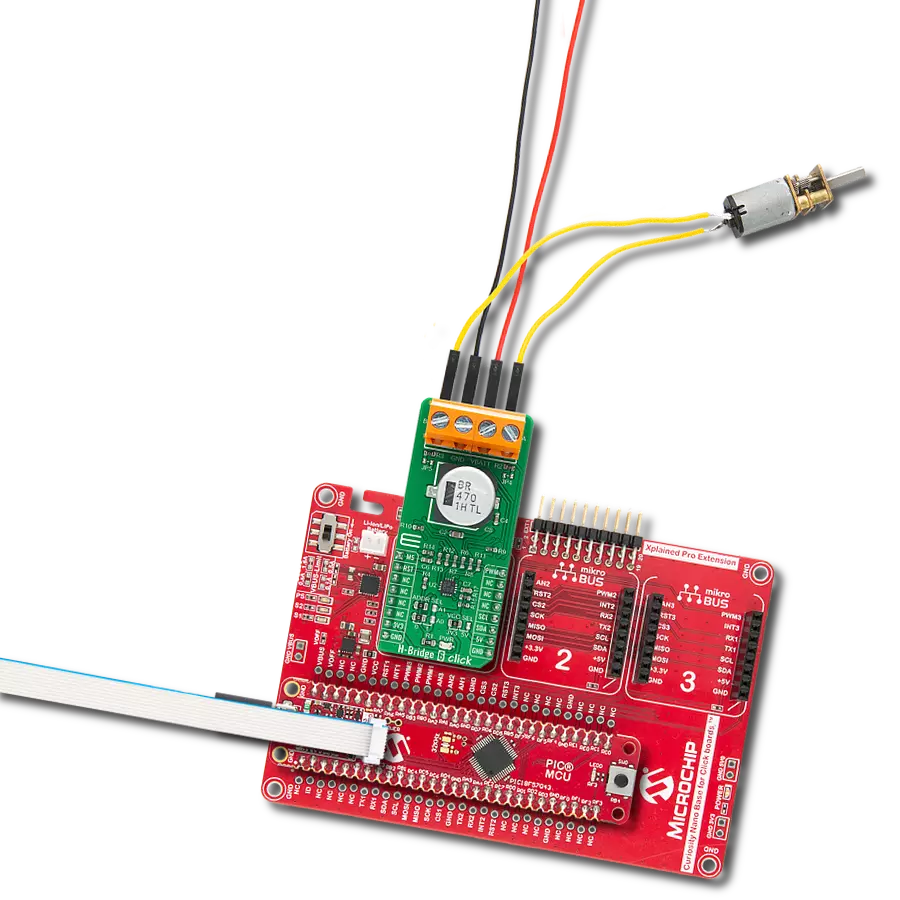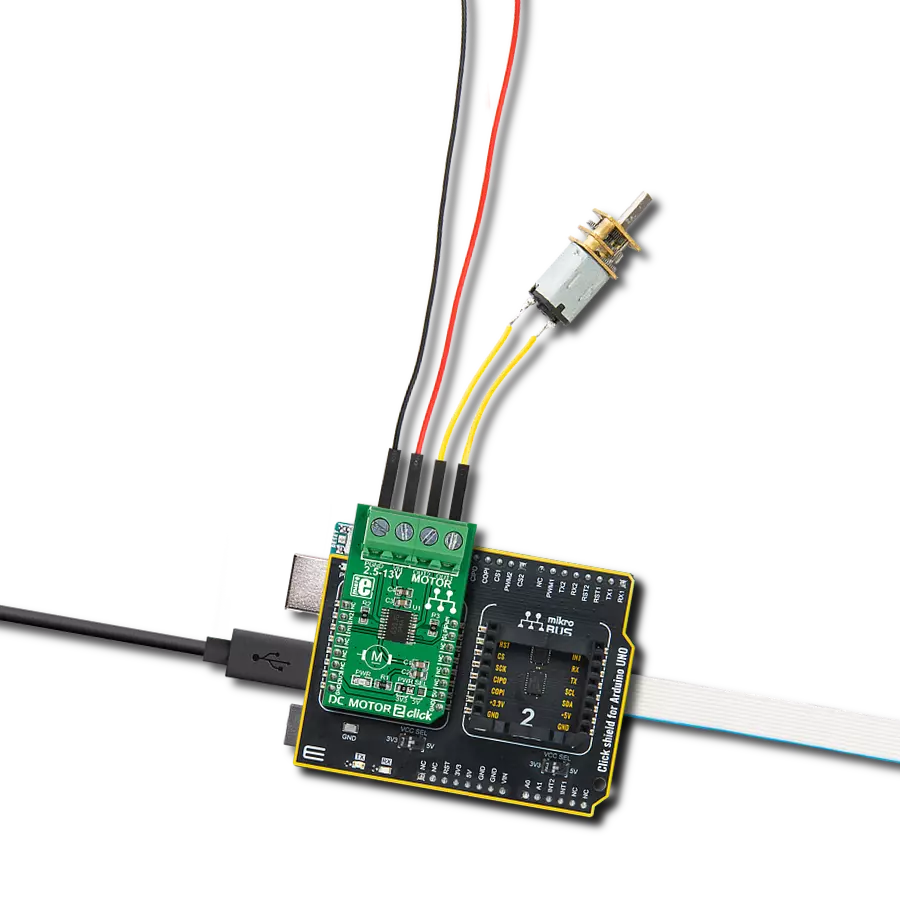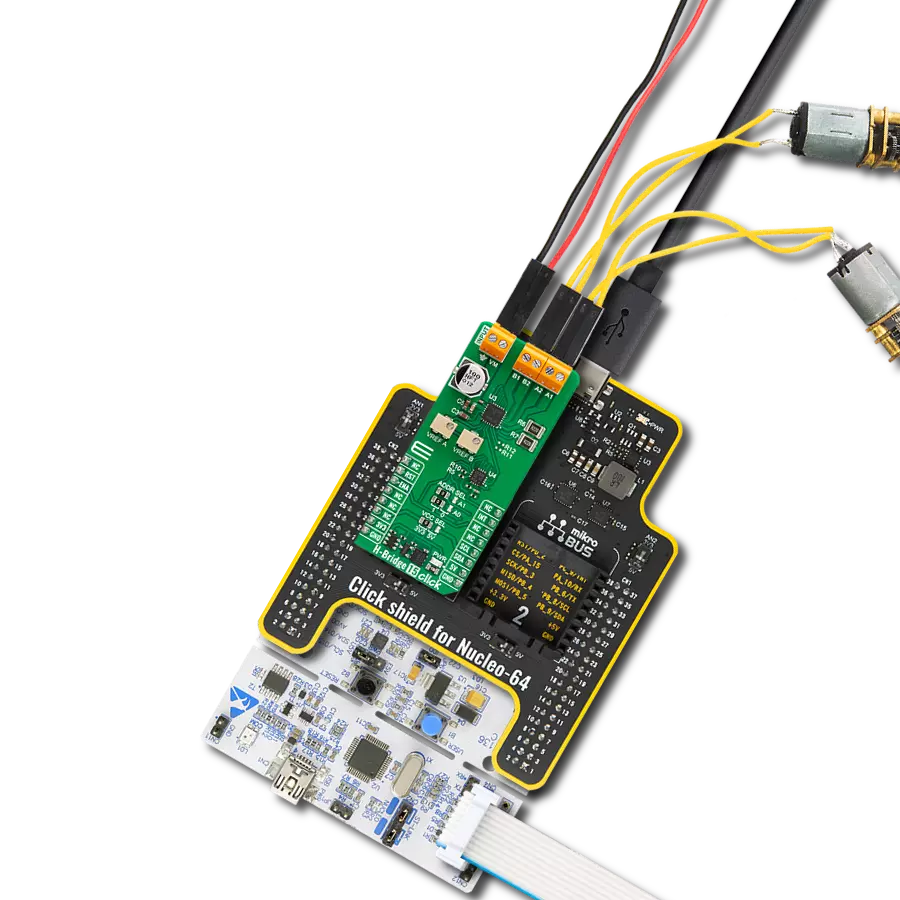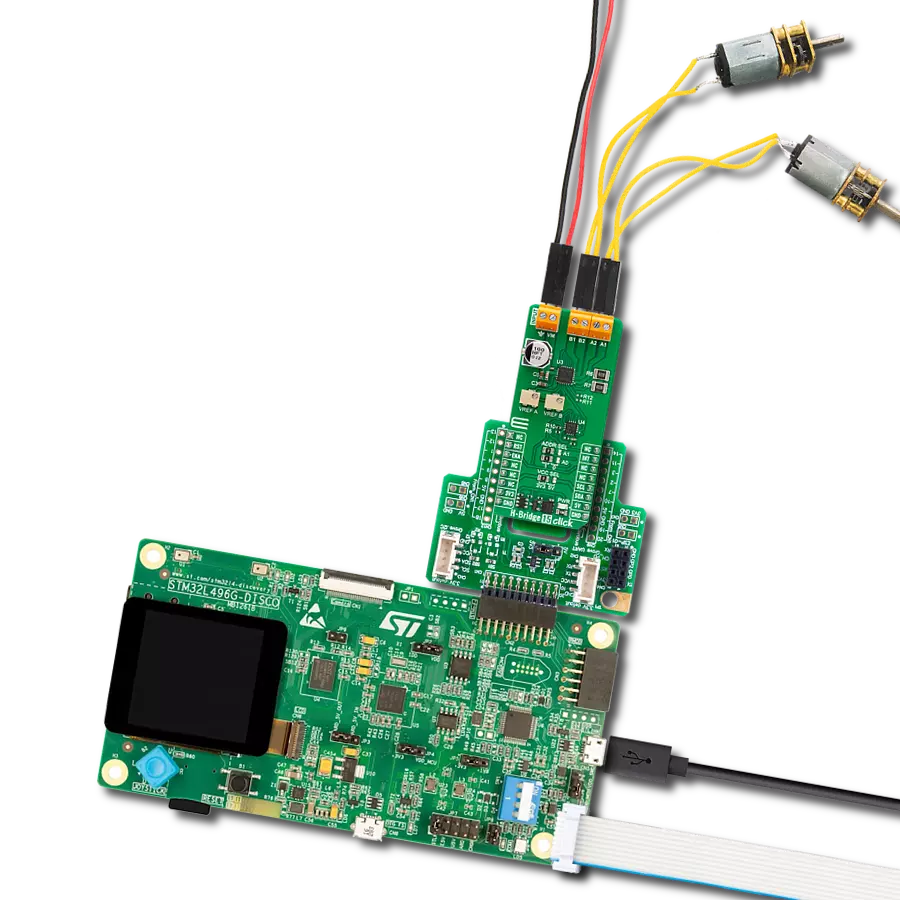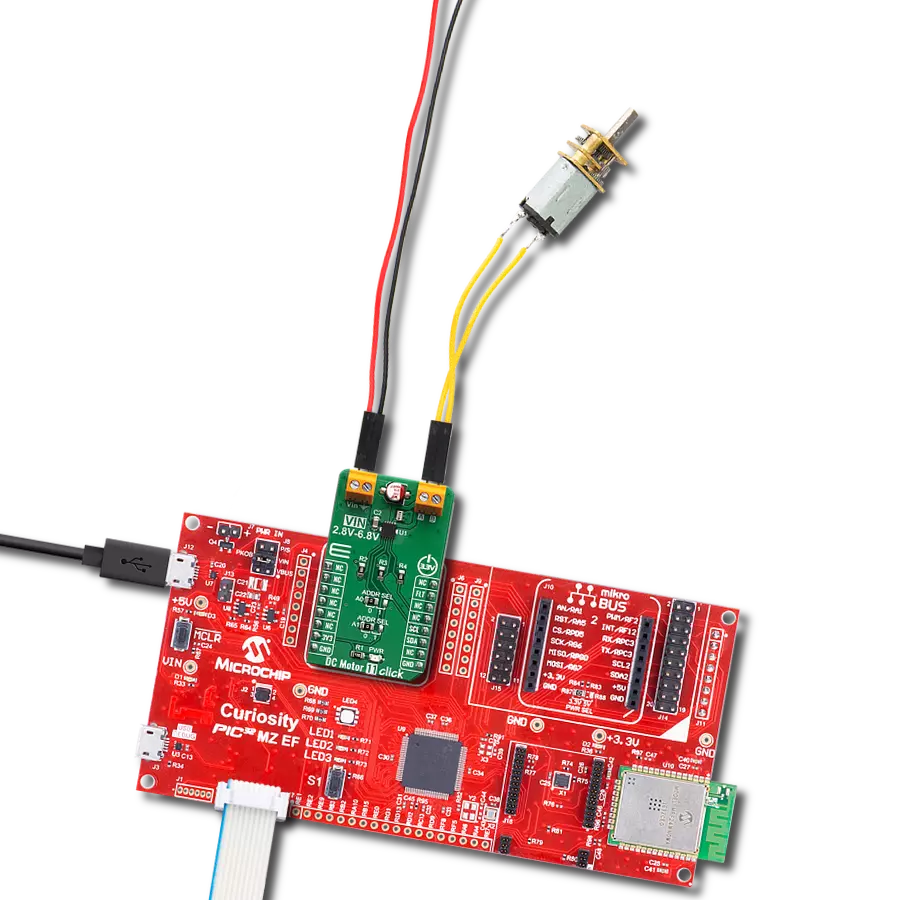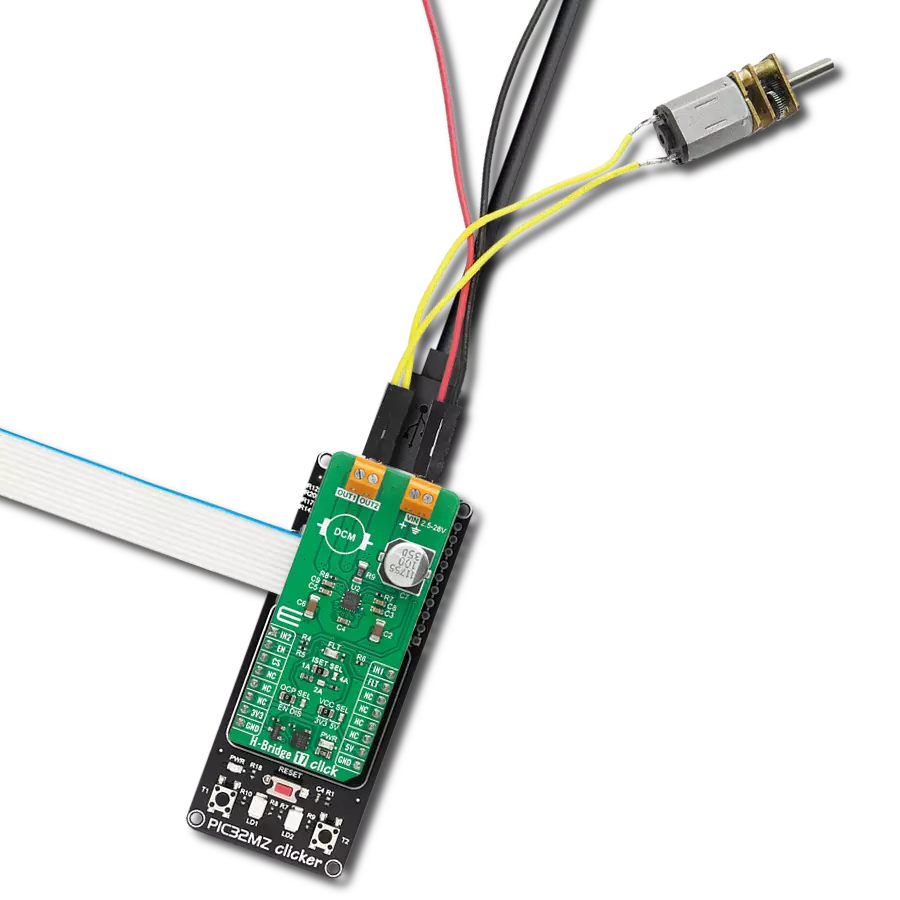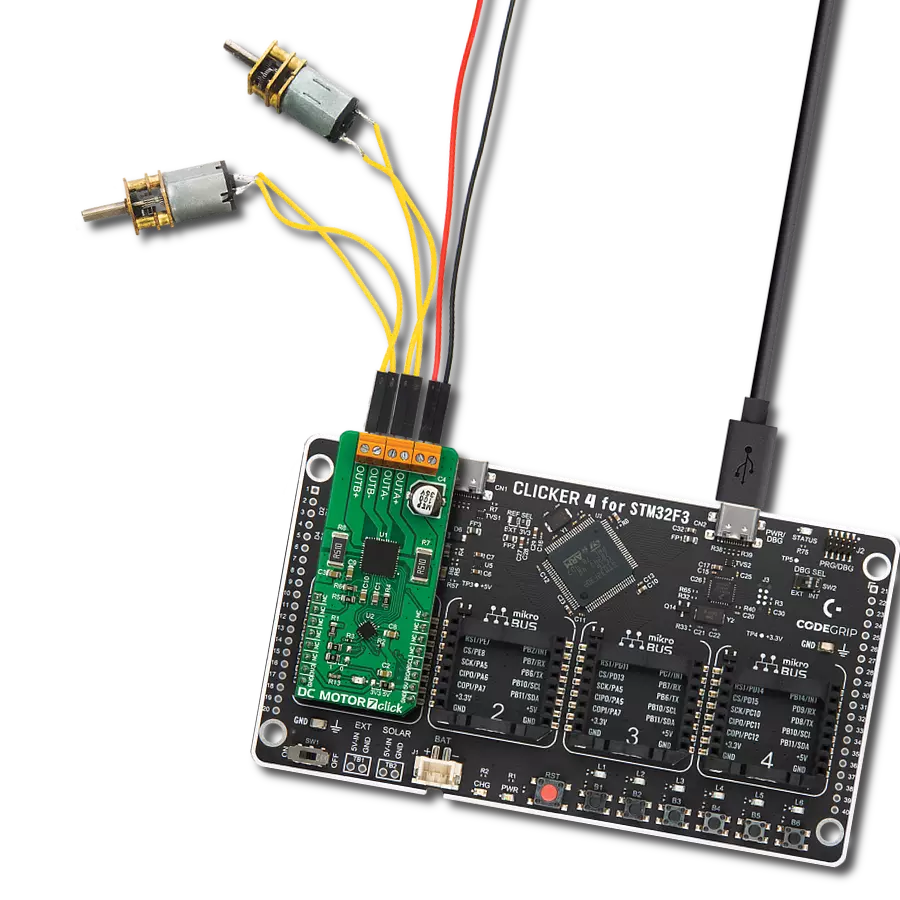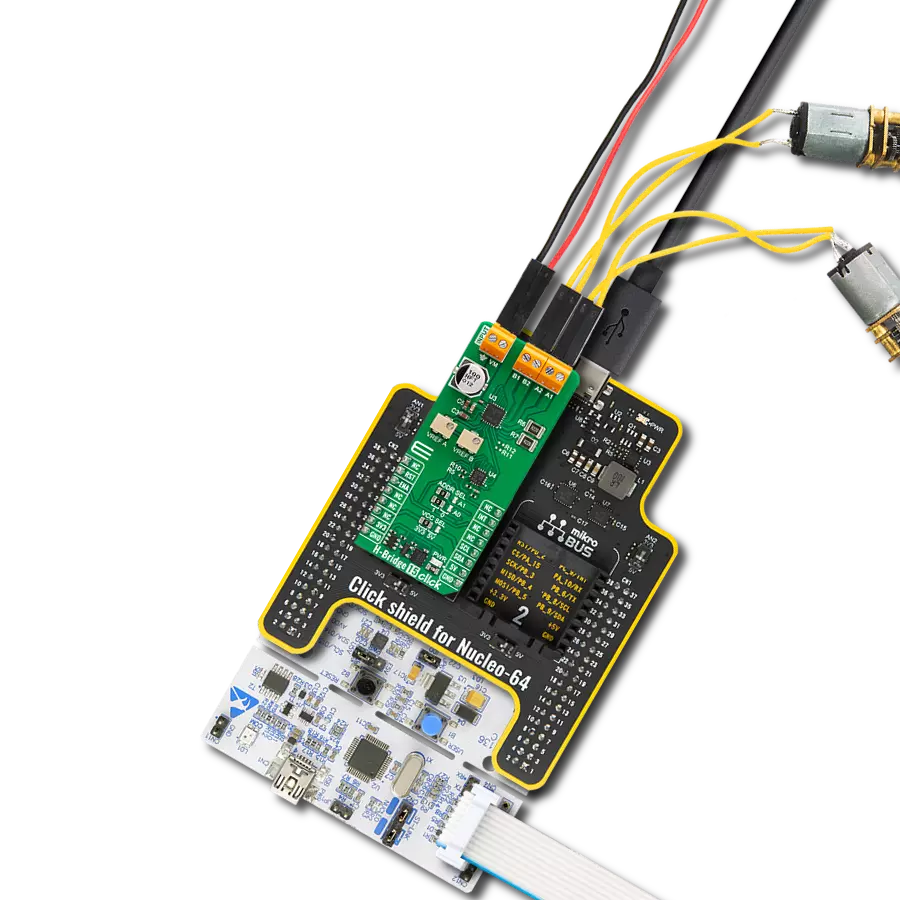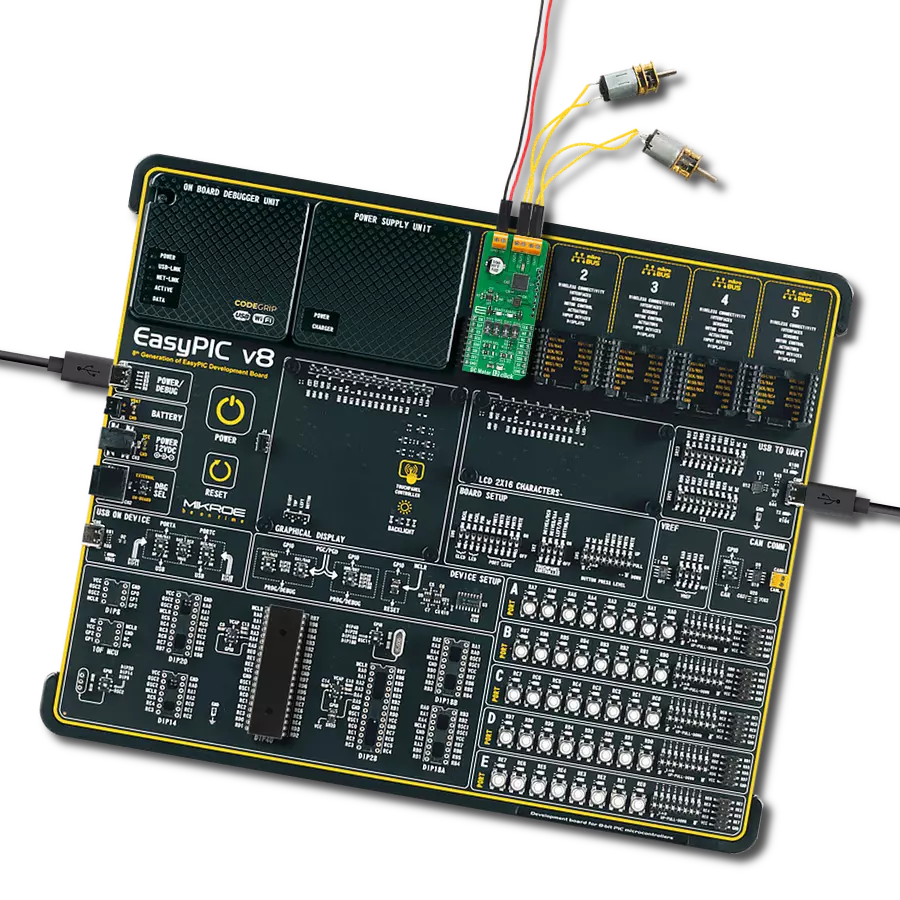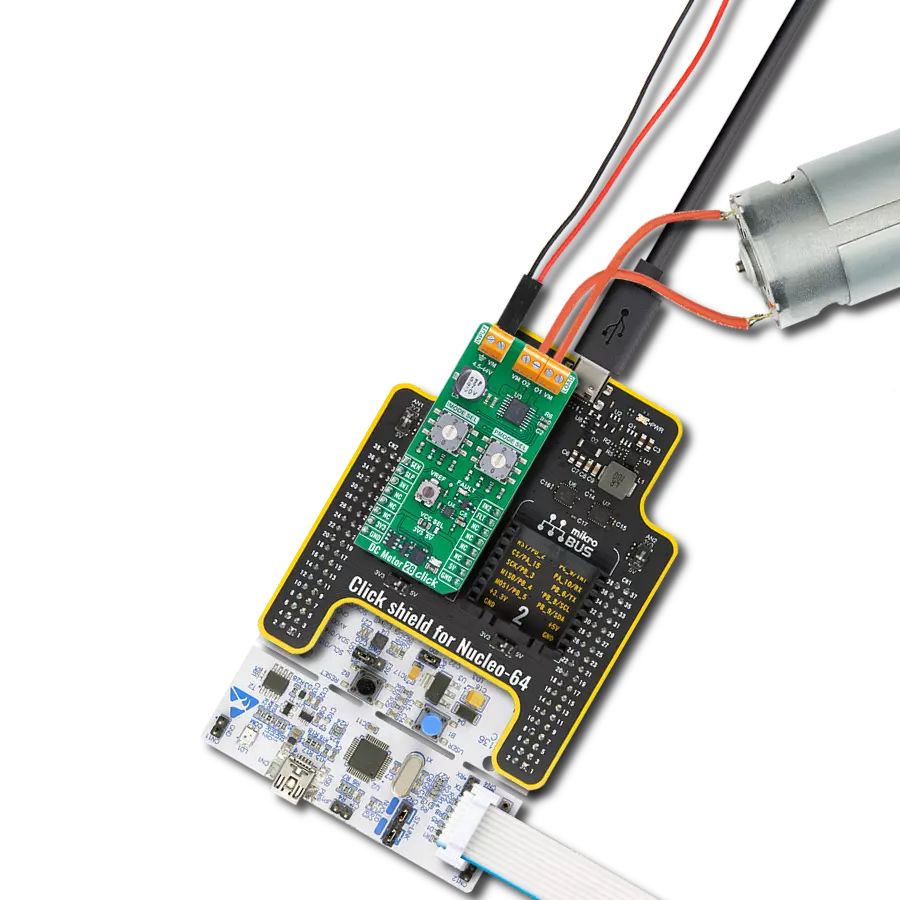使用我们可靠且适应性强的直流电机驱动器解决方案,简化您的运动控制挑战,并在各个行业中提升性能。
A
A
硬件概览
它是如何工作的?
DC Motor 23 Click基于东芝半导体的TB67H480FNG设计,它是一款双通道、H桥、刷式直流电机驱动器。TB67H480FNG具有电流限制功能,监测电机中的电流。当电机电流达到通过板载VREF调节器(VREFA和VREFB)确定的设定电流值时,它将转换到衰减模式,可以通过将标有DECAY的SMD跳线器定位到标有0和1的适当位置进行选择,以获得固定的关断时间并减小电流。TB67H480FNG具有内置调节器,可使电机由单一电源驱动,提供约40V的电机输出电压评级,并具有诸如过流、过温和欠压锁定等综合保护机制,用于错误检测。设置电流值可以通过扭矩功能(100%、
71%、38%或0%)进行调整,通过PCA9538A端口扩展器进行控制,该扩展器通过I2C串行接口与MCU建立通信。当不需要高扭矩时,降低扭矩设置可以抑制电机电流。除了这些扭矩设置引脚外,借助扩展器,还可以控制其他一些信号,例如用于选择电机驱动器操作模式的控制信号。这些引脚与ENA和ENB引脚一起,路由到mikroBUS™插座的CS和PWM引脚的默认位置,可以启用CW、CCW或短路刹车等操作模式。PCA9538A还允许通过将标有ADDR SEL的SMD跳线器定位到标有0和1的适当位置来选择其I2C从地址的最低有效位(LSB),并将其中断特性路由到mikroBUS™插座的INT引脚。此外,可以使
用路由到mikroBUS™插座的AN引脚的默认位置的Sleep功能停止所有电路,并启用省电模式,而RST引脚提供通用复位功能。DC Motor 23 Click支持连接到标有VM的输入端子的TB67H480FNG的外部电源,该电源应在8.2V至44V的范围内,而两个刷式电机或一个步进电机线圈可以连接到标有B+、B-、A-和A+的端子上。此Click板可以通过VCC SEL跳线器选择3.3V或5V逻辑电压电平运行。这样,既支持3.3V又支持5V的MCU可以正确使用通信线路。此外,该Click板配备了一个包含易于使用的函数和示例代码的库,可用作进一步开发的参考。
功能概述
开发板
Flip&Click PIC32MZ 是一款紧凑型开发板,设计为一套完整的解决方案,它将 Click 板™的灵活性带给您喜爱的微控制器,使其成为实现您想法的完美入门套件。它配备了一款板载 32 位 PIC32MZ 微控制器,Microchip 的 PIC32MZ2048EFH100,四个 mikroBUS™ 插槽用于 Click 板™连接,两个 USB 连接器,LED 指示灯,按钮,调试器/程序员连接器,以及两个与 Arduino-UNO 引脚兼容的头部。得益于创
新的制造技术,它允许您快速构建具有独特功能和特性的小工具。Flip&Click PIC32MZ 开发套件的每个部分都包含了使同一板块运行最高效的必要组件。此外,还可以选择 Flip&Click PIC32MZ 的编程方式,使用 chipKIT 引导程序(Arduino 风格的开发环境)或我们的 USB HID 引导程序,使用 mikroC、mikroBasic 和 mikroPascal for PIC32。该套件包括一个通过 USB 类型-C(USB-C)连接器的干净且调
节过的电源供应模块。所有 mikroBUS™ 本身支持的 通信方法都在这块板上,包括已经建立良好的 mikroBUS™ 插槽、用户可配置的按钮和 LED 指示灯。Flip&Click PIC32MZ 开发套件允许您在几分钟内创建新的应用程序。它由 Mikroe 软件工具原生支持,得益于大量不同的 Click 板™(超过一千块板),其数量每天都在增长,它涵盖了原型制作的许多方面。
微控制器概述
MCU卡片 / MCU
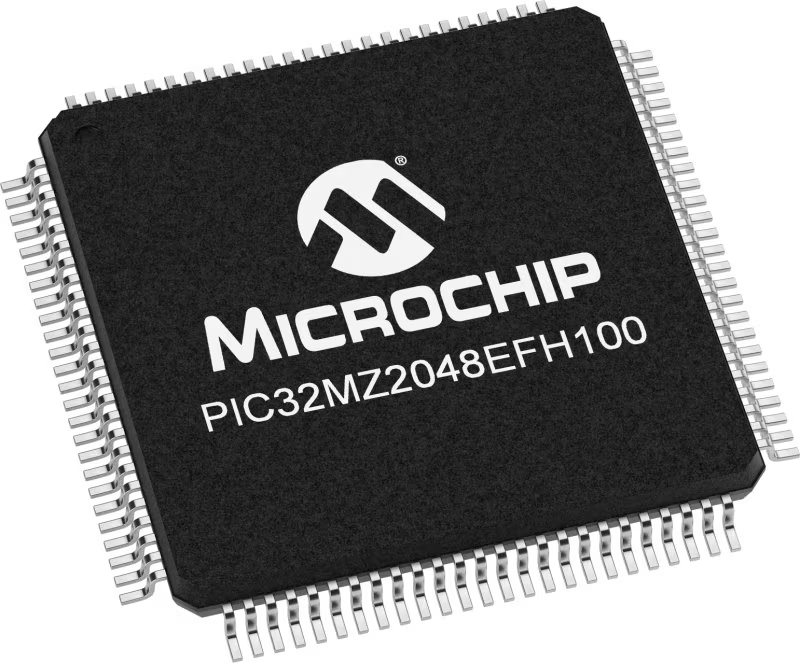
建筑
PIC32
MCU 内存 (KB)
2048
硅供应商
Microchip
引脚数
100
RAM (字节)
524288
你完善了我!
配件
使用的MCU引脚
mikroBUS™映射器
“仔细看看!”
Click board™ 原理图

一步一步来
项目组装
软件支持
库描述
该库包含 DC Motor 23 Click 驱动程序的 API。
关键功能:
dcmotor23_set_clockwise- 直流电机23设置顺时针功能。dcmotor23_set_counter_clockwise- 直流电机23设置逆时针功能。dcmotor23_set_decay- 直流电机23设置衰减功能。
开源
代码示例
完整的应用程序代码和一个现成的项目可以通过NECTO Studio包管理器直接安装到NECTO Studio。 应用程序代码也可以在MIKROE的GitHub账户中找到。
/*!
* @file main.c
* @brief DC Motor 23 Click example
*
* # Description
* This example demonstrates the use of DC Motor 23 Click board™.
* by driving the motors in both direction every 3 seconds.
*
* The demo application is composed of two sections :
*
* ## Application Init
* Initializes the driver and performs the Click default configuration
* which sets the output torque to 100%.
*
* ## Application Task
* This example demonstrates the use of the DC Motor 23 Click board™.
* Drives the motors in the clockwise direction,
* after that decay the motors with a 3 seconds delay
* then switches to the counter-clockwise direction,
* and decay the motors with a 3 seconds delay.
* Results are being sent to the UART Terminal, where you can track their changes.
*
* @author Nenad Filipovic
*
*/
#include "board.h"
#include "log.h"
#include "dcmotor23.h"
static dcmotor23_t dcmotor23;
static log_t logger;
void application_init ( void )
{
log_cfg_t log_cfg; /**< Logger config object. */
dcmotor23_cfg_t dcmotor23_cfg; /**< Click config object. */
/**
* Logger initialization.
* Default baud rate: 115200
* Default log level: LOG_LEVEL_DEBUG
* @note If USB_UART_RX and USB_UART_TX
* are defined as HAL_PIN_NC, you will
* need to define them manually for log to work.
* See @b LOG_MAP_USB_UART macro definition for detailed explanation.
*/
LOG_MAP_USB_UART( log_cfg );
log_init( &logger, &log_cfg );
log_info( &logger, " Application Init " );
// Click initialization.
dcmotor23_cfg_setup( &dcmotor23_cfg );
DCMOTOR23_MAP_MIKROBUS( dcmotor23_cfg, MIKROBUS_1 );
if ( I2C_MASTER_ERROR == dcmotor23_init( &dcmotor23, &dcmotor23_cfg ) )
{
log_error( &logger, " Communication init." );
for ( ; ; );
}
if ( DCMOTOR23_ERROR == dcmotor23_default_cfg ( &dcmotor23 ) )
{
log_error( &logger, " Default configuration." );
for ( ; ; );
}
log_info( &logger, " Application Task " );
log_printf ( &logger, "--------------------------\r\n" );
}
void application_task ( void )
{
if ( DCMOTOR23_OK == dcmotor23_set_clockwise( &dcmotor23, DCMOTOR23_SEL_OUT_A ) )
{
log_printf ( &logger, " OUTA: Clockwise\r\n" );
}
if ( DCMOTOR23_OK == dcmotor23_set_clockwise( &dcmotor23, DCMOTOR23_SEL_OUT_B ) )
{
log_printf ( &logger, " OUTB: Clockwise\r\n\n" );
}
Delay_ms ( 1000 );
Delay_ms ( 1000 );
Delay_ms ( 1000 );
if ( DCMOTOR23_OK == dcmotor23_set_decay( &dcmotor23, DCMOTOR23_SEL_OUT_A ) )
{
log_printf ( &logger, " OUTA: Decay\r\n" );
}
if ( DCMOTOR23_OK == dcmotor23_set_decay( &dcmotor23, DCMOTOR23_SEL_OUT_B ) )
{
log_printf ( &logger, " OUTB: Decay\r\n\n" );
}
Delay_ms ( 1000 );
Delay_ms ( 1000 );
Delay_ms ( 1000 );
if ( DCMOTOR23_OK == dcmotor23_set_counter_clockwise( &dcmotor23, DCMOTOR23_SEL_OUT_A ) )
{
log_printf ( &logger, " OUTA: Counter-Clockwise\r\n" );
}
if ( DCMOTOR23_OK == dcmotor23_set_counter_clockwise( &dcmotor23, DCMOTOR23_SEL_OUT_B ) )
{
log_printf ( &logger, " OUTB: Counter-Clockwise\r\n\n" );
}
Delay_ms ( 1000 );
Delay_ms ( 1000 );
Delay_ms ( 1000 );
if ( DCMOTOR23_OK == dcmotor23_set_decay( &dcmotor23, DCMOTOR23_SEL_OUT_A ) )
{
log_printf ( &logger, " OUTA: Decay\r\n" );
}
if ( DCMOTOR23_OK == dcmotor23_set_decay( &dcmotor23, DCMOTOR23_SEL_OUT_B ) )
{
log_printf ( &logger, " OUTB: Decay\r\n" );
}
log_printf ( &logger, "--------------------------\r\n" );
Delay_ms ( 1000 );
Delay_ms ( 1000 );
Delay_ms ( 1000 );
}
int main ( void )
{
/* Do not remove this line or clock might not be set correctly. */
#ifdef PREINIT_SUPPORTED
preinit();
#endif
application_init( );
for ( ; ; )
{
application_task( );
}
return 0;
}
// ------------------------------------------------------------------------ END



















